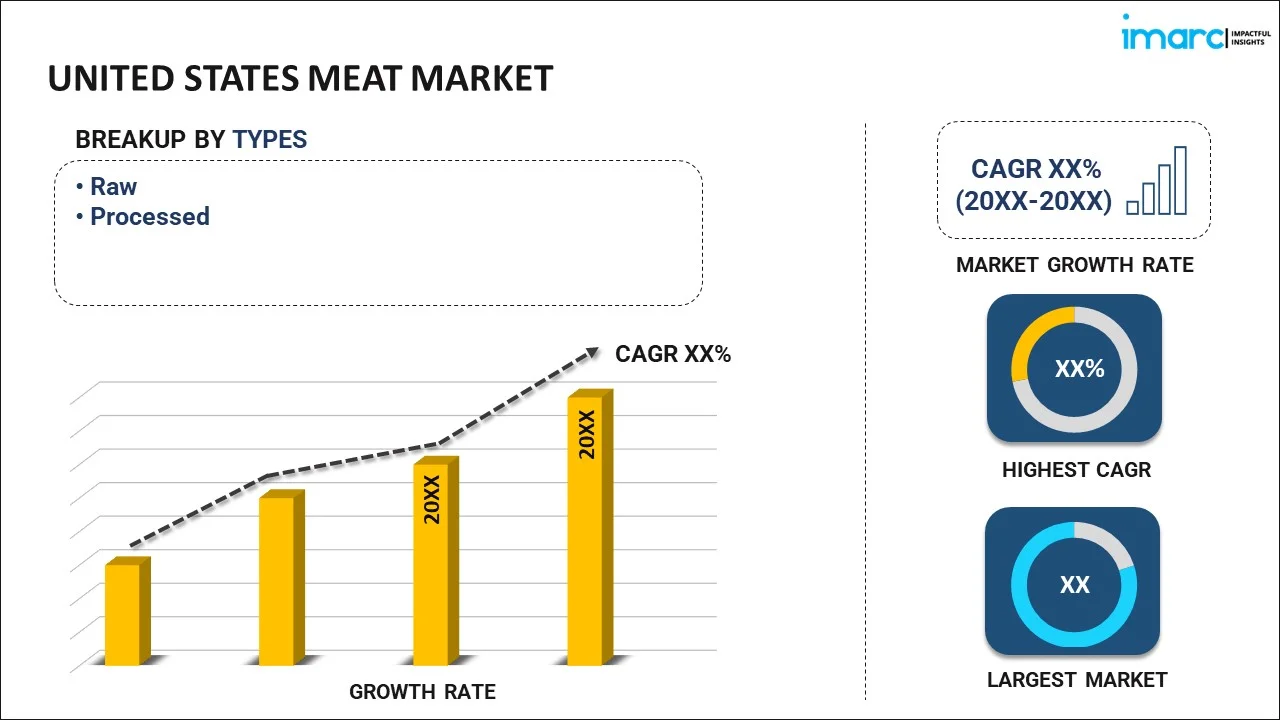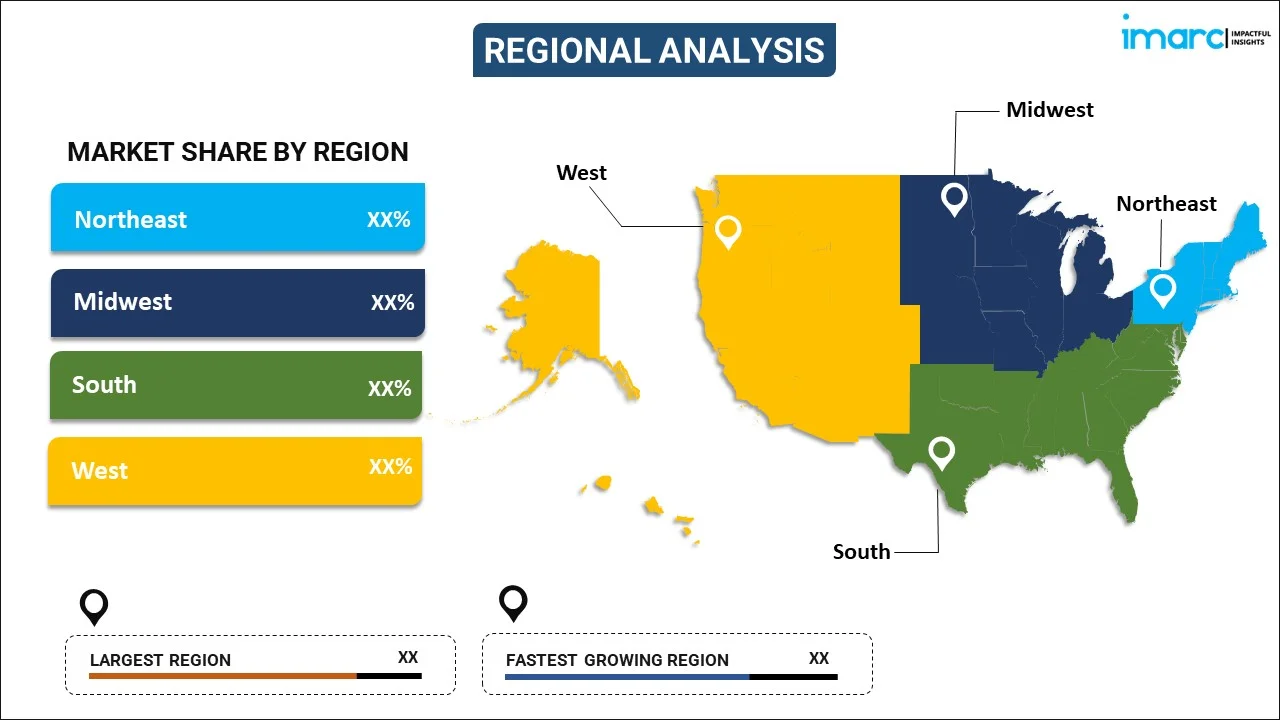
United States Meat Market Report by Type (Raw, Processed), Product (Chicken, Beef, Pork, Mutton, and Others), Distribution Channel (Supermarkets and Hypermarkets, Departmental Stores, Specialty Stores, Online Stores, and Others), and Region 2025-2033
Market Overview:
The United States meat market size reached USD 358 Billion in 2024. Looking forward, IMARC Group expects the market to reach USD 480 Billion by 2033, exhibiting a growth rate (CAGR) of 3.3% during 2025-2033. The rising consumer preferences for alternative protein sources, increasing consciousness regarding health and wellness, changing dietary choices of individuals, and supportive government regulations represent some of the key factors driving the market.
|
Report Attribute
|
Key Statistics
|
|---|---|
|
Base Year
|
2024 |
|
Forecast Years
|
2025-2033
|
|
Historical Years
|
2019-2024
|
| Market Size in 2024 | USD 358 Billion |
| Market Forecast in 2033 | USD 480 Billion |
| Market Growth Rate (2025-2033) | 3.3% |
Meat is a primary food source derived from the flesh of animals, typically livestock such as cattle, poultry, pork, and fish. It is a significant protein provider in human diets and has been a fundamental part of culinary traditions across various cultures for centuries. The composition of meat includes muscle tissue, along with varying amounts of fat, connective tissue, and other components. This nutrient-dense food offers a range of essential amino acids, vitamins, and minerals (such as iron and zinc), contributing to overall human health and well-being. Meat comes in different forms, including fresh, processed, and cured varieties. Fresh meat refers to raw, unprocessed cuts obtained directly from the animal, whereas processed meat undergoes techniques such as smoking, curing, or cooking to enhance flavor, texture, and preservation. Processed meat products, such as sausages, bacon, and deli meats, provide convenient options for consumption and are often used in various culinary applications. As a result, meat has gained immense popularity as a rich source of protein and essential nutrients and is widely consumed across the United States.
United States Meat Market Trends:
In the United States, consumer preferences and dietary choices have witnessed a noticeable shift in recent years. There is a growing demand for alternative protein sources, including plant-based meats and meat substitutes. This trend is driven by factors such as health concerns, environmental consciousness, and ethical considerations. In addition, with the inflating consumer purchasing power, individuals are more inclined to buy premium cuts or specialty meats. Along with this, the rising consumption of convenience foods, ready-to-eat (RTE) meals, snacks, and ethnic cuisines is contributing to the market growth. Moreover, the increasing focus on health and wellness has augmented the demand for leaner cuts, organic meats, and products with reduced additives or preservatives. Besides this, there is a growing interest in sustainable and regenerative agricultural practices leading to higher demand for meat products sourced from animals raised with higher welfare standards. This is further supported by the implementation of supportive government regulations and policies related to food safety, labeling, animal welfare, and environmental sustainability in the United States. Furthermore, technological advancements, such as the adoption of precision agriculture, data analytics, and automation technologies, have improved efficiency and productivity in meat production and processing. In line with this, continuous innovations in cellular agriculture and cultured meat hold the potential to provide alternative methods of meat production that require fewer resources and have a reduced environmental impact. This is anticipated to create a positive outlook for the market in the coming years.
United States Meat Market Segmentation:
IMARC Group provides an analysis of the key trends in each segment of the United States meat market report, along with forecasts at the country level for 2025-2033. Our report has categorized the market based on type, product, and distribution channel.
Type Insights:

- Raw
- Processed
The report has provided a detailed breakup and analysis of the United States meat market based on the type. This includes raw and processed.
Product Insights:
- Chicken
- Beef
- Pork
- Mutton
- Others
A detailed breakup and analysis of the United States meat market based on the product has also been provided in the report. This includes chicken, beef, pork, mutton, and others.
Distribution Channel Insights:
- Supermarkets and Hypermarkets
- Departmental Stores
- Specialty Stores
- Online Stores
- Others
The report has provided a detailed breakup and analysis of the United States meat market based on the distribution channel. This includes supermarkets and hypermarkets, departmental stores, specialty stores, online stores, and others.
Regional Insights:

- Northeast
- Midwest
- South
- West
The report has also provided a comprehensive analysis of all the major regional markets, which include Northeast, Midwest, South, and West.
Competitive Landscape:
The report has also provided a comprehensive analysis of the competitive landscape in the United States meat market. Competitive analysis such as market structure, key player positioning, top winning strategies, competitive dashboard, and company evaluation quadrant has been covered in the report. Also, detailed profiles of all major companies have been provided.
United States Meat Market Report Coverage:
| Report Features | Details |
|---|---|
| Base Year of the Analysis | 2024 |
| Historical Period | 2019-2024 |
| Forecast Period | 2025-2033 |
| Units | Billion USD |
| Scope of the Report | Exploration of Historical and Forecast Trends, Industry Catalysts and Challenges, Segment-Wise Historical and Predictive Market Assessment:
|
| Types Covered | Raw, Processed |
| Products Covered | Chicken, Beef, Pork, Mutton, Others |
| Distribution Channels Covered | Supermarkets and Hypermarkets, Departmental Stores, Specialty Stores, Online Stores |
| Regions Covered | Northeast, Midwest, South, West |
| Customization Scope | 10% Free Customization |
| Post-Sale Analyst Support | 10-12 Weeks |
| Delivery Format | PDF and Excel through Email (We can also provide the editable version of the report in PPT/Word format on special request) |
Key Questions Answered in This Report:
- How has the United States meat market performed so far and how will it perform in the coming years?
- What has been the impact of COVID-19 on the United States meat market?
- What is the breakup of the United States meat market on the basis of type?
- What is the breakup of the United States meat market based on product?
- What is the breakup of the United States meat market on the basis of distribution channel?
- What are the various stages in the value chain of the United States meat market?
- What are the key driving factors and challenges in the United States meat market?
- What is the structure of the United States meat market and who are the key players?
- What is the degree of competition in the United States meat market?
Key Benefits for Stakeholders:
- IMARC’s report offers a comprehensive quantitative analysis of various market segments, historical and current market trends, market forecasts, and dynamics of the United States meat market from 2019-2033.
- The research study provides the latest information on the market drivers, challenges, and opportunities in the United States meat market.
- Porter's five forces analysis assist stakeholders in assessing the impact of new entrants, competitive rivalry, supplier power, buyer power, and the threat of substitution. It helps stakeholders to analyze the level of competition within the United States meat industry and its attractiveness.
- Competitive landscape allows stakeholders to understand their competitive environment and provides an insight into the current positions of key players in the market.
Need more help?
- Speak to our experienced analysts for insights on the current market scenarios.
- Include additional segments and countries to customize the report as per your requirement.
- Gain an unparalleled competitive advantage in your domain by understanding how to utilize the report and positively impacting your operations and revenue.
- For further assistance, please connect with our analysts.
 Request Customization
Request Customization
 Speak to an Analyst
Speak to an Analyst
 Request Brochure
Request Brochure
 Inquire Before Buying
Inquire Before Buying




.webp)




.webp)












